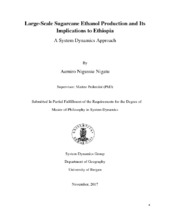Large-Scale Sugarcane Ethanol Production and Its Implications to Ethiopia: A System Dynamics Approach
Master thesis
Permanent lenke
https://hdl.handle.net/1956/17477Utgivelsesdato
2017-12-21Metadata
Vis full innførselSamlinger
- Department of Geography [627]
Sammendrag
Ethiopia imports oil products for its fuel requirements, and the demand for fuel is rapidly increasing. Research indicates that imported fuel accounts for the lion‟s share of the total import expenditure and absorbs much of the total export earnings, closer to 75%. Oil consumption from the transport sector is growing especially fast, accounts for nearly 49.5 % of the imported oil every year. Coupled with the fact that Ethiopia is a land locked country with no oil reserves, the issue has become a bottle neck for the overall development in the country. On top of its effect on the country‟s trade balance, significant increase in the GHG emission released from fossil fuel combustion in the transport sector is also another area of concern. In order to reduce oil import dependency and support the green economy effort in the country, ethanol production and official blending have been started since 2007. Although a lot of sugar factories are being built, the production and consumption of ethanol have shown a steady progress against the country‟s goals to make a shift to renewable energy sources and the need to build a greener economy. Hence, bio-fuel accounts for a small share in the transport sector. This is of concern because the resources used to produce sugar in the existing sugar factories are simply wasted when it is possible to further process and produce ethanol without requiring additional land use and other input changes. Various theories across agriculture, economics, energy, and environment sectors were combined and applied to build a bio-fuel energy simulation model for representing ethanol production on a country level. The model is calibrated to the case of Ethiopia and its sugar factories in order to test a large scale sugarcane ethanol production from molasses, a by-product from sugar factories that used to be thrown and dumped to rivers. Simulation results suggest that the current inputs in the sugar industry, land, water and capital, theoretically have the potential to significantly increase the level of ethanol production and reduce the level of oil products imported every year. Scenario tests indicate that outlining the appropriate blending strategy is vital for the sustainable and consistent implementation of ethanol substitution in the transport sector, and that performance could be further improved when ethanol production cost is subsidized for an amount of 3500 ETB per TOE ethanol.
